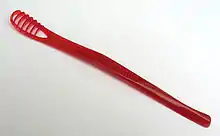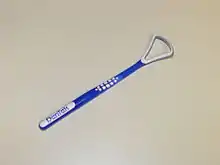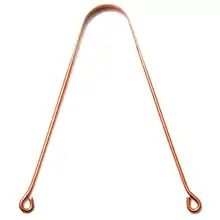Tongue cleaner
A tongue cleaner (also called a tongue scraper or tongue brush) is an oral hygiene device designed to clean the coating on the upper surface of the tongue. While there is tentative benefit from the use of a tongue cleaner it is insufficient to draw clear conclusions regarding bad breath.[1] A 2006 Cochrane review found tentative evidence of decreased levels of odor molecules.[2]



The large surface area and lingual papilla are anatomical features of the tongue that promote tongue coating by retaining microorganisms and oral debris consisting of food, saliva and dead epithelial cells.[3][4][5] Tongue cleaning is done less often than tooth brushing, flossing, and using mouthwash.[3][4]
Health effects
Breath
While there is tentative benefit from the use of a tongue cleaner it is insufficient to draw clear conclusions with respect to bad breath.[1] A 2006 Cochrane review found tentative evidence of decreased levels of odor molecules.[2]
Some studies have shown that it is the bacteria on the tongue which often produce malodorous compounds and fatty acids that may account for 80% to 85% of all cases of bad breath.[6][7] The remaining 15% to 20% of cases originate in the stomach, from the tonsils, from decaying food stuck between the teeth, gum disease, dental caries (cavities or tooth decay) or plaque accumulated on the teeth.[5] In addition, degradation of oral debris by microorganisms produce organosulfur compounds (volatile sulphur compounds) on the posterior (rear) of the tongue.[1][5]
Aesthetics
The tongue is normally pink in appearance.[5] It may acquire a white or colored coating due to diet, reduced salivary flow, reduced oral hygiene or tongue anatomy.[3][5] The thickness of the tongue coating can also vary.[3][4] Tongue cleaning can reduce this coating to make it cleaner and to help return it to its natural pink color.[4][1]
Dental caries and periodontal disease
The tongue surface can be a reservoir for tooth pathogens and periodontal pathogens.[8] It can contribute to the recolonization of tooth surfaces.[8] People with periodontal disease are more likely to have a thicker tongue coating and a microbial flora that produces more volatile sulphur compounds compared to those who have healthy periodontal tissues.[1][5] Tongue cleaning might help to reduce halitosis, dental caries and periodontal disease.[3]
Side effects
Tongue cleaning can cause discomfort.[4] Improper use of a tongue cleaner may induce the gag reflex and/or vomiting.[1][3] Overuse of a tongue cleaner may also cause damage to the taste buds. Some people have inappropriately used the tongue cleaner to scrape or brush the lingual tonsils (tongue tonsils).[9]
There has been one reported case where a woman possibly had infective endocarditis from bacteremia following the use of a tongue cleaner. Individuals with previous infective endocarditis and high-risk cardiac valves may be at a higher risk from bacteremia.[10]
History

Ayurveda, the practice of traditional Indian medicine, recommends tongue cleaning as part of one's daily hygiene regimen, to remove the toxic debris, known as Ama.[11][12] Tongue cleaning has existed in Ayurvedic practice since ancient times, using tongue scrapers made from copper, silver, gold, tin or brass.[11] In modern time, plastic scrapers are used in India and the Far East.[11]
Tongue hygiene has been practiced for centuries in Africa, Arabia, Europe, South America and many eastern and oriental cultures.[3][5][10] The various materials used for tongue cleaners include thin flexible wood sections, metals, ivory, mother-of-pearl, whalebone, celluloid, tortoiseshell, and plastic.[12]
Western civilizations placed less emphasis on tongue cleaning.[5][12] Between the 15th and 19th century, tongue cleaning was primarily practiced by those who were affluent.[3] It was recorded in Europe in the 18th and 19th centuries that Romans also performed tongue cleaning.[12] In the 20th century, a wide variety of tongue cleaning devices came on the commercial market.[11]
Types
The top surface of the tongue can be cleaned using a tongue cleaner, a tongue brush/scraper or a toothbrush.[1][3] However, toothbrushes are not considered as effective for this purpose because they have a smaller width and are designed for brushing teeth, which have a solid structure unlike the spongy tissue of the tongue.[7] This can reduce its ability to remove debris and microorganisms.[7] Some toothbrush designs have projections on the back of their heads to act as a tongue cleaner.[1]
Ergonomic tongue cleaners are shaped in accordance with the anatomy of the tongue, and are optimized to lift and trap the plaque coating and effectively clean the surface of the tongue.[3] There are many different types of tongue cleaners. They can be plastic or metal straps, plastic and/or small brush bristles that form "rakes" or circular devices with handles.[3] Their effectiveness varies depending on the shape, dimensions, configuration, quality of the contact surfaces and materials used. Tongue cleaners are mostly inexpensive, small, easy to clean and durable.[3]
See also
References
- Van der Sleen, Mi; Slot, De; Van Trijffel, E; Winkel, Eg; Van der Weijden, Ga (2010-11-01). "Effectiveness of mechanical tongue cleaning on breath odour and tongue coating: a systematic review". International Journal of Dental Hygiene. 8 (4): 258–268. doi:10.1111/j.1601-5037.2010.00479.x. ISSN 1601-5037. PMID 20961381.
- Outhouse, TL; Al-Alawi, R; Fedorowicz, Z; Keenan, JV (19 April 2006). Outhouse, Trent L (ed.). "Tongue scraping for treating halitosis". The Cochrane Database of Systematic Reviews (2): CD005519. doi:10.1002/14651858.CD005519.pub2. PMID 16625641. (Retracted, see doi:10.1002/14651858.cd005519.pub3)
- Christensen, G. J. (1998-11-01). "Why clean your tongue?". Journal of the American Dental Association. 129 (11): 1605–1607. doi:10.14219/jada.archive.1998.0109. ISSN 0002-8177. PMID 9818580.
- Bordas, Alice; McNab, Rod; Staples, Angela M.; Bowman, Jim; Kanapka, Joe; Bosma, Marylynn P. (2008-04-01). "Impact of different tongue cleaning methods on the bacterial load of the tongue dorsum". Archives of Oral Biology. 53 Suppl 1: S13–18. doi:10.1016/S0003-9969(08)70004-9. ISSN 0003-9969. PMID 18460399.
- Danser, M. M; Gómez, S. Mantilla; Van der Weijden, G. A (2003-08-01). "Tongue coating and tongue brushing: a literature review". International Journal of Dental Hygiene. 1 (3): 151–158. doi:10.1034/j.1601-5037.2003.00034.x. ISSN 1601-5037. PMID 16451515.
- Van Den Broek, Amwt; Feenstra, L; De Baat, C (2008-01-01). "A review of the current literature on management of halitosis". Oral Diseases. 14 (1): 30–39. doi:10.1111/j.1601-0825.2006.01350.x. ISSN 1601-0825. PMID 18173446.
- Pedrazzi, Vinícius; Sato, Sandra; de Mattos, Maria da Gĺoria Chiarello; Lara, Elza Helena Guimarães; Panzeri, Heitor (2004-07-01). "Tongue-cleaning methods: a comparative clinical trial employing a toothbrush and a tongue scraper". Journal of Periodontology. 75 (7): 1009–1012. doi:10.1902/jop.2004.75.7.1009. ISSN 0022-3492. PMID 15341360.
- Faveri, Marcelo; Feres, Magda; Shibli, Jamil Awad; Hayacibara, Roberto F.; Hayacibara, Mitsue M.; de Figueiredo, Luciene Cristina (2006-09-01). "Microbiota of the dorsum of the tongue after plaque accumulation: an experimental study in humans". Journal of Periodontology. 77 (9): 1539–1546. doi:10.1902/jop.2006.050366. ISSN 0022-3492. PMID 16945032.
- Yaegaki, K.; Coil, J. M. (2000-05-01). "Examination, classification, and treatment of halitosis; clinical perspectives". Journal (Canadian Dental Association). 66 (5): 257–261. ISSN 1488-2159. PMID 10833869.
- Redmond, Andrew M.; Meiklejohn, Cathryn; Kidd, Timothy J.; Horvath, Robert; Coulter, Christopher (2007-09-01). "Endocarditis after use of tongue scraper". Emerging Infectious Diseases. 13 (9): 1440–1441. doi:10.3201/eid1309.070544. ISSN 1080-6040. PMC 2857304. PMID 18252139.
- Rupesh, S; Winnier, Jj; Nayak, Ua; Rao, Ap; Reddy, V; Peter, J (2012-05-01). "The comparative evaluation of the effects of tongue cleaning on salivary levels of mutans streptococci in children". International Journal of Dental Hygiene. 10 (2): 107–112. doi:10.1111/j.1601-5037.2011.00522.x. ISSN 1601-5037. PMID 21797979.
- Beekmans, Dg; Slot, De; Van der Weijden, Ga (2016-02-01). "User perception on various designs of tongue scrapers: an observational survey". International Journal of Dental Hygiene. 15 (4): e1–e8. doi:10.1111/idh.12204. ISSN 1601-5037. PMID 26865433. S2CID 10096526.